NCERT Solutions for Class 10 Maths Chapter 11 Constructions
NCERT Solutions Exercise 11.1 Class 10 Constructions
In each of the following, give the justification of the construction also:
Question 1.
Draw a line segment of length 7.6 cm and divide it in the ratio 5:8. Measure the two parts.
Solution:
Steps of Construction:
- 1. Draw a line segment AB = 7.6 cm.
- 2. Draw an acute angle BAX on base AB. Mark the ray as AX.
- 3. Locate 13 points A1, A2, A3, …… , A13 on the ray AX so that AA1 = A1A2 = ……… = A12A13
- 4. Join A13 with B and at A5 draw a line ∥ to BA13, i.e. A5C. The line intersects AB at C.
- 5. On measure AC = 2.9 cm and BC = 4.7 cm.
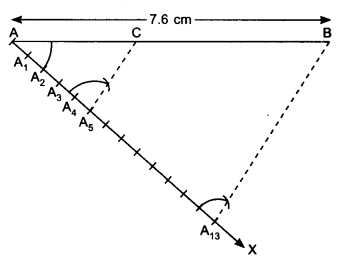
Justification:
In ∆AA5C and ∆AA13B,

∴ AC : BC = 5 : 8
Question 2.
Construct a triangle of sides 4 cm, 5 cm and 6 cm and then a triangle similar to it whose sides are 2/3 of the corresponding sides of the first triangle.
Solution:
Steps of Construction:
- 1. Construct a ∆ABC with AB = 4 cm, BC = 6 cm and AC = 5 cm.
- 2. Draw an acute angle CBX on the base BC at point B. Mark the ray as BX.
- 3. Mark the ray BX with B1, B2, B3 such that
- BB1 = B1B2 = B2B3
- 4. Join B3 to C.
- 5. Draw B2C’ ∥ B3C, where C’ is a point on BC.
- 6. Draw C’A’ ∥ AC, where A’ is a point on BA.
- 7. ∆A’BC’ is the required triangle.
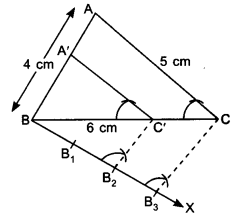
Justification: In ∆A’BC and ∆ABC,
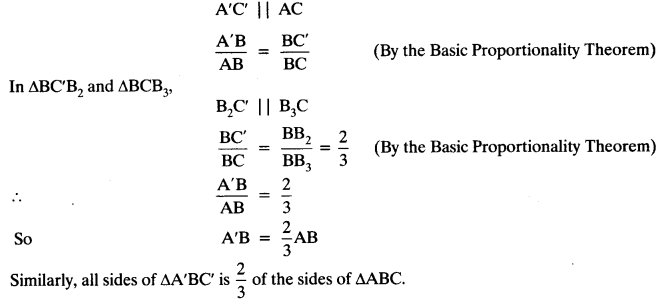
Question 3.
Construct a triangle with sides 5 cm, 6 cm and 7 cm and then another triangle whose sides are 7/5 of the corresponding sides of the first triangle.
Solution:
Steps of Construction:
- 1. Draw a ∆ABC with AB = 5 cm, BC = 7 cm and AC = 6 cm.
- 2. Draw an acute angle CBX below BC at point B.
- 3. Mark the ray BX as B1, B2, B3, B4, B5, B6 and B7 such that BB1= B1B2 = B2B3 = B3B4 = B4B5 = B5B6 = B6B7.
- 4. Join B5 to C.
- 5. Draw B7C’ parallel to B5C, where C’ is a point on extended line BC.
- 6. Draw A’C’ ∥ AC, where A’ is a point on extended line BA.
- A’BC’ is the required triangle.
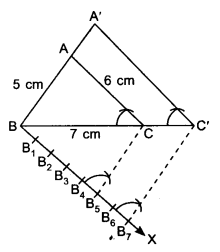
Justification: In ∆ABC and ∆A’BC’,


Question 4.
Construct an isosceles triangle whose base is 8 cm and altitude 4 cm and then another triangle whose sides are 1 1/2 times the corresponding sides of the isosceles triangle.
Solution:
Steps of Construction:
- 1. Draw base AB = 8 cm.
- 2. Draw perpendicular bisector of AB. Mark CD = 4 cm, on ⊥ bisector where D is mid-point on AB.
- 3. Draw an acute angle BAX, below AB at point A.
- 4. Mark the ray AX with A1, A2, A3 such that AA1 =A1A2 = A2A3
- 5. Join A2 to B. Draw A3B’ ∥ A2 B, where B’ is a point on extended line AB.
- 6. At B’, draw B’C’ 11 BC, where C’ is a point on extended line AC.
- 7. ∆AB’C’ is the required triangle.
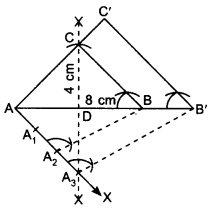
Justification: In ∆ABC and ∆A’BC’,
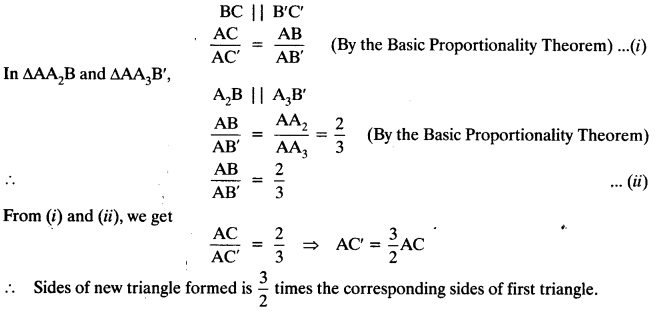
Question 5.
Draw a triangle ABC with side BC = 6 cm, AB = 5 cm and ∠ABC = 60°. Then construct a triangle whose sides are 3/4 of the corresponding sides of the triangle ABC.
Solution:
Steps of Construction:
- 1. Draw a line segment BC = 6 cm and at point B draw an ∠ABC = 60°.
- 2. Cut AB = 5 cm. Join AC. We obtain a ∆ABC.
- 3. Draw a ray BX making an acute angle with BC on the side opposite to the vertex A.
- 4. Locate 4 points A1, A2, A3 and A4 on the ray BX so that BA1 = A1A2 = A2A3 = A3A4.
- 5. Join A4 to C.
- 6. At A3, draw A3C’ ∥ A4C, where C’ is a point on the line segment BC.
- 7. At C’, draw C’A’ ∥ CA, where A’ is a point on the line segment BA.
∴ ∆A’BC’ is the required triangle.
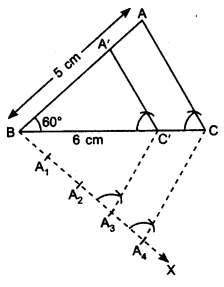
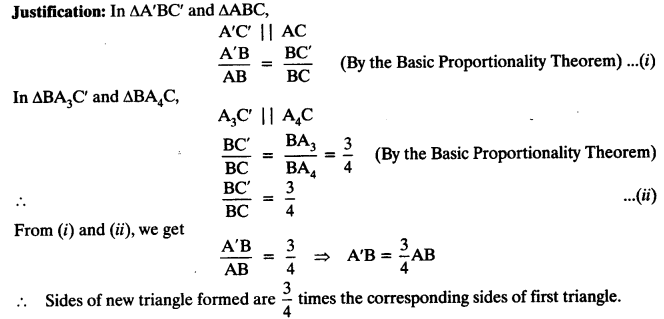
Question 6.
Draw a triangle ABC with side BC = 7 cm, ∠B = 45°, ∠A = 105°. Then, construct a triangle whose sides are 43 times the corresponding sides of ∆ABC.
Solution:
In ∆ABC, ∠A + ∠B + ∠C = 180°
⇒ 105° + 45° + ∠C = 180°
⇒ 150° + ∠C = 180°
⇒ ∠C = 30°
Steps of Construction:
1. Draw a line segment BC = 7 cm. At point B, draw an ∠B = 45° and at point C, draw an ∠C = 30° and get ΔABC.
2. Draw an acute ∠CBX on the base BC at point B. Mark the ray BX with B1, B2, B3, B4, such that BB1 = B1B2 = B2B3 = B3B4
3. Join B3 to C.
4. Draw B4C’ ∥ B3C, where C’ is point on extended line segment BC.
5. At C’, draw C’A’ ∥ AC, where A’ is a point on extended line segment BA.
6. ∆A’BC’ is the required triangle.
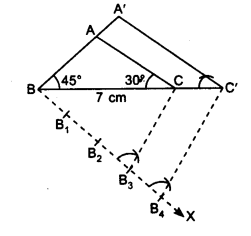
Justification: In ∆ABC and ∆A’BC’,
Question 7.
Draw a right triangle in which the sides (other than hypotenuse) are of lengths 4 cm and 3 cm. Then construct another triangle whose sides are 5/3F times the corresponding sides of the given triangle.
Solution:
Steps of Construction:
- 1. Draw a right angled ∆ABC with AB = 4 cm, AC = 3 cm and ∠A = 90°.
- 2. Make an acute angle BAX on the base AB at point A.
- 3. Mark the ray AX with A1, A2, A3, A4, A5 such that AA1 = A1A2 = A2A3 = A3A4 = A4A5.
- 4. Join A3B. At A5, draw A5B’ ∥ A3B, where B’ is a point on extended line segment AB.
- 5. At B’, draw B’C’ ∥ BC, where C’ is a point on extended line segment AC.
- 6. ∆AB’C’ is the required triangle.
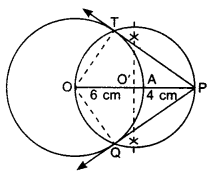
Justification:
In ∆ABC and ∆AB’C’,


NCERT Solutions Exercise 11.2 Class 10 Constructions
In each of the following, give the justification of the construction also:
Question 1.
Draw a circle of radius 6 cm. From a point 10 cm away from its centre, construct the pair of tangents to the circle and measure their lengths.
Solution:
Steps of Construction:
- 1. Draw a circle of radius 6 cm.
- 2. Mark a point P at a distance 10 cm from the centre O.
- 3. Here OP = 10 cm, draw perpendicular bisector of OP, which intersects OP at O’.
- 4. Take O’ as centre, draw a circle of radius O’O, which passes through O and P and intersects the previous circle at points T and Q.
- 5. Join PT and PQ, measure them, these are the required tangents.
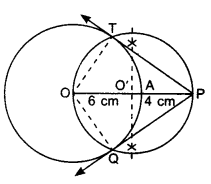
Justification:
Join OT and OQ.

A pair of tangents can be drawn to a circle from an external point outside the circle. These two tangents are equal in lengths.
∴ PT = PQ.
Question 2.
Construct a tangent to a circle of radius 4 cm from a point on the concentric circle of radius 6 cm and measure its length. Also verify the measurement by actual calculation.
Solution:
Steps of Construction:
- 1. Draw concentric circles of radius OA = 4 cm and OP = 6 cm having same centre O.
- 2. Mark these circles as C and C’.
- 3. Points O, A and P lie on the same line.
- 4. Draw perpendicular bisector of OP, which intersects OP at O’.
- 5. Take O’ as centre, draw a circle of radius OO’ which intersects the circle C at points T and Q.
- 6. Join PT and PQ, these are the required tangents.
- 7. Length of these tangents are approx. 4.5 cm.
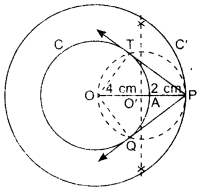
Justification:
Join OT and OQ.

A pair of tangents can be drawn to a circle from an external point outside the circle. These two tangents are equal in lengths.
∴ PT = PQ.
Question 3.
Draw a circle of radius 3 cm. Take two points P and Q on one of its extended diameter each at a distance of 7 cm from its centre. Draw tangents to the circle from these two points P and Q.
Solution:
Steps of Construction:
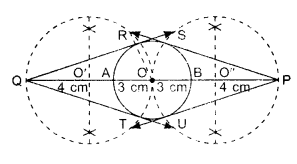
- 1. Draw a circle of radius 3 cm, having centre O. Mark this circle as C.
- 2. Mark points P and Q along its extended diameter such that OP = 7 cm and OQ = 7 cm.
- 3. Draw perpendicular bisector of OQ, intersecting OQ at O’.
- 4. Draw perpendicular bisector of OP intersecting OP at O”.
- 5. Take O’ as centre and draw a circle of radius OO’ which passes through points O and Q, intersecting circle C at points R and T.
- 6. Take O” as centre and draw a circle of radius O”P which passes through points O and P, intersecting the, circle C at points S and U.
- 7. Join QR and QT; PS and PU, these are the required tangents.
Justification:
Join OR.
In ∆OQR,
OR ⊥ QR [Radius ± to tangent]
OQ2 = OR2 + QR2
⇒ (7)2 = (3)2 + QR2 ⇒ 49 = 9 + OR2
⇒ 40 = QR2 ⇒ QR = 2 √10 cm
Similary,
QT = 2 √10 cm
PS = 2 √10 cm
PU = 2 √10 cm
A pair of tangents can be drawn to a circle from an external point outside the circle. These two tangents are equal in lengths.
∴ QR = QT and PS = PU
Question 4.
Draw a pair of tangents to a circle of radius 5 cm which are inclined to each other at an angle of 60°.
Solution:
Steps of Construction:
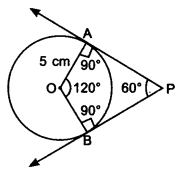
- 1. Draw a circle of radius 5 cm.
- 2. As tangents are inclined to each other at an angle of 60°.
- ∴ Angle between the radii of circle is 120°. (Use quadrilateral property)
- 3. Draw radii OA and OB inclined to each other at an angle 120°.
- 4. At points A and B, draw 90° angles. The arms of these angles intersect at point P.
- 5. PA and PB are the required tangents.
Justification:
In quadrilateral AOBP,
AP and BP are the tangents to the circle.
Join OP.
In right angled AOAP, OA ⊥ PA [Radius is ⊥ to tangent]
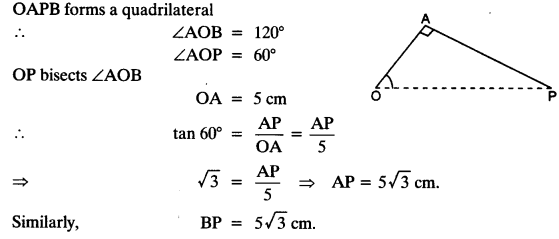
A pair of tangents can be drawn to a circle from an external point outside the circle. These two tangents are equal in lengths.
∴ PA = PB
Question 5.
Draw a line segment AB of length 8 cm. Taking A as centre, draw a circle of radius 4 cm and taking B as centre, draw another circle of radius 3 cm. Construct tangents to each circle from the centre of the other circle.
Solution:
Steps of Construction:
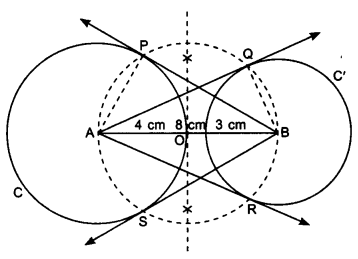
- 1. Draw a line segment AB = 8 cm.
- 2. Taking A as centre draw a circle C of radius 4 cm and taking B as centre draw a circle C’ of radius 3 cm.
- 3. Draw perpendicular bisector of AB, which intersects AB at point O.
- 4. Taking point O as centre draw a circle of radius 4 cm passing through points A and B which intersect circle C at P and S and circle C’ at points R and Q.
- 5. Join AQ, AR, BP and BS. These are the required tangents.
Justification:
Join AP.
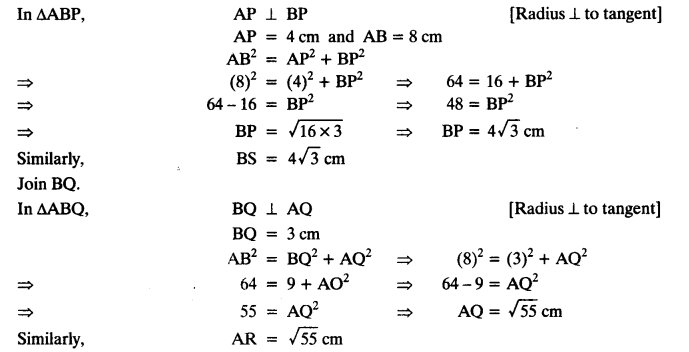
A pair of tangents can be drawn to a circle from an external point outside the circle. These two tangents are equal in lengths.
∴ AQ = AR and BP = BS.
Question 6.
Let ABC be a right triangle in which AB = 6 cm, BC = 8 cm and ZB = 90°. BD is the perpendicular Burn B on AC. The circle through B, C, D is drawn. Construct the tangents from A to this circle.
Solution:
Steps of Construction:
- 1. Draw a right triangle ABC with AB = 6 cm, BC = 8 cm and ZB = 90°.
- 2. From B, draw BD perpendicular to AC.
- 3. Draw perpendicular bisector of BC which intersect BC at point O’.
- 4. Take O’ as centre and O’B as radius, draw a circle C’ passes through points B, C and D.
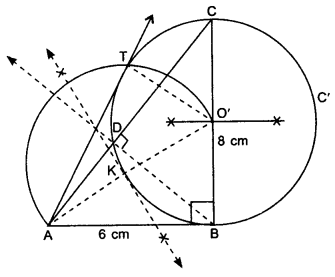
5. Join O’A and draw perpendicular bisector of O’A which intersect O’A at point K.
6. Take K as centre, draw an arc of radius KO’ intersect the previous circle C’ at T.
7. Join AT, AT is required tangent.
Justification:
∠BDC = 90°
∴ BC acts as diameter.
AB is tangent to circle having centre O’
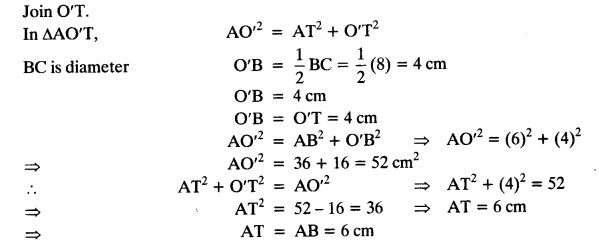
A pair of tangents can be drawn to a circle from an external point outside the circle. These two tangents are equal in lengths.
∴ AB = AT.
Question 7.
Draw a circle with the help of a bangle. Take a point outside the circle. Construct the pair of tangents from this point to the circle.
Solution:
Steps of Construction:
1. Draw a circle C’ with the help of a bangle, for finding the centre, take three non-collinear points A, B and C, lying on the circle. Join AB and BC and draw perpendicular bisector of AB and BC, both intersect at a point O,
‘O’ is centre of the circle.
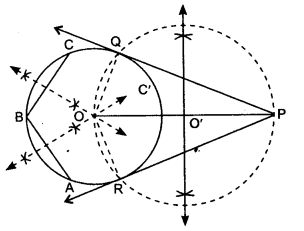
2. Take a point P outside the circle. Join OP.
3. Draw perpendicular bisector of OP, which intersects OP at point O’.
4. Take O’ as the centre with OO’ as radius draw a circle which passes through O and P, intersecting previous circle C’ at points R and Q.
5. Join PQ and PR.
6. PQ and PR are the required pair of tangents.
Justification:
Join OQ and OR.
In AOQP and AOPR, OQ = OR [Radii of the circle]
OP = OP [Common]
∠Q = ∠R = 90° [Radius is ⊥ to tangent]
∆OQP ≅ ∆ORP [by RHS]
∴ PQ = PR [By C.P.C.T]
A pair of tangents can be drawn to a circle from an external point lying outside the circle. These two tangents are equal in lengths.
∴ PQ = PR